Does The Division live up to its promise?
A first look proper reveals an exciting if familiar game.
Following the widely perceived Watch Dogs downgrade from its spectacular E3 2012 reveal to its eventual release last month, there's been much attention on Ubisoft's wider line-up - and whether, following its similarly spectacular reveal at last year's show, The Division will follow the same trajectory. A first look proper, away from the blinding testosterone levels of an E3 conference, gives something of a mixed answer.
What The Division has in abundance is atmosphere - a cold, bleak atmosphere that's creaking in the grim frost encasing its abandoned New York. The backdrop is pure Clancy-universe hokum - diseased dollar bills creating chaos on a near-apocalyptic scale - but it makes for what could be one of the most memorable video game locations in quite some time. There are stories embedded across the city's architecture; a dead policeman slumped down the side of a car telling of a firefight that passed some days ago, or bloodstains on the walls of an apartment hinting at a more domestic tragedy.
The streets are dense with detail that stretches far into a cold mist, the Snowdrop engine doing a fantastic job of painting a viral spread of urban decay that's taken down an entire city. It's a spread, though, that can be slowly reined in, and that's where the dazzle of The Division settles into something a little more familiar.
As you patrol the open world, you'll be able to see the security and contagion levels of districts and zones - and by battling through enemies you can gain control of the map, area by area, by setting up bases of operation. You've played this before - either on an annual basis in a historical setting of Ubisoft's choice, in the far-flung tropics, or more recently around a hyper-connected Chicago. There's no sign of a tailing mission - yet - but still, this is very much an Ubisoft Open World Game™.
It is a very promising Ubisoft Open World Game™, though, with a keen eye for detail. When capturing one area that's under the control of The Cleaners - a faction who go in and purge infected areas - piles of bodies burn grotesquely in a warehouse, heavily guarded by a group whose obsession with hygiene stretches towards the extreme. Once the area's been cleared of enemies, the electricity's restored, sparking off sprinklers that douse the flames while a decorated wintry tree cutely lights up.
In keeping with The Division's RPG trappings, and the hardware fetishism that comes hand-in-hand with the Clancy licence, the systems run deep, and there's a strong sense it'll be as easy to get lost in the game's tech trees as it will be to get lost in its rich open world. Upgrades for items are unlocked through progression, accessible at any point in a conical skill tree that allows you to re-mod your arsenal at any point. The far-fetched gadgetry is a delight, too - grenades can receive seeker mods that see them smartly darting towards enemies deeply embedded in cover, while strobes blind and dazzle soldiers leaving them prone for a swift takedown.
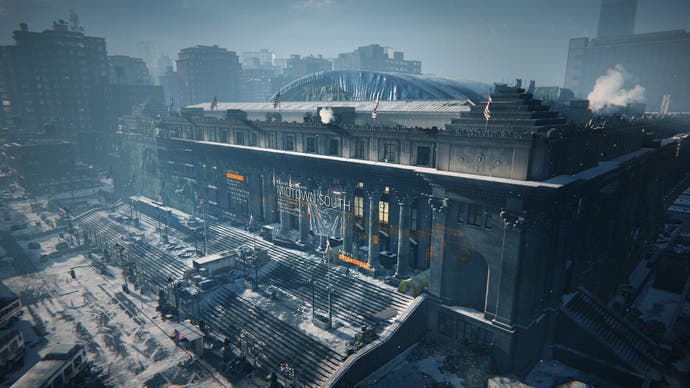
The interface is a marvel as well, taking advantage of The Division's near-future setting to present maps that are projected across the game world, or tech trees that spring brightly from the player character's watch. The Division's RPG leanings mean there's a complex web running underneath its running and gunning, but they're neatly embedded within the fiction and the world.
Some elements are a little more creaky, though. Drones can scout out ahead of the player, and can be controlled synchronously by a friend with a tablet, who's also able to drop in ammo and assisting items. It's a cute idea, even if it does feel like it's turned up late to a party that never really started - the idea of other players joining in on second screens burned bright a while back at E3, yet it's never really gained any traction, and it's a little disconcerting that one of The Division's key points of differentiation right now is a concept that's already extinct.
There's more that will mark The Division out, for sure, though much of remains a mystery for now. How connected are its players, and how will they work against each other as well as alongside each other? It's no problem that the backbone of The Division feels a little familiar, but whether it can deliver on its early promise depends much on how Ubisoft builds out on its well-established template.




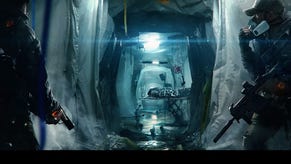
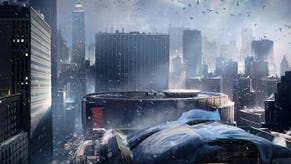


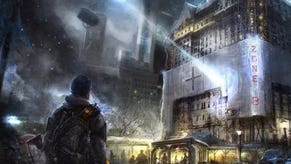

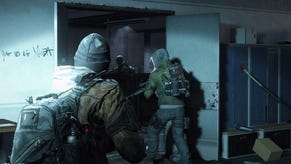



.png?width=291&height=164&fit=crop&quality=80&format=jpg&auto=webp)



